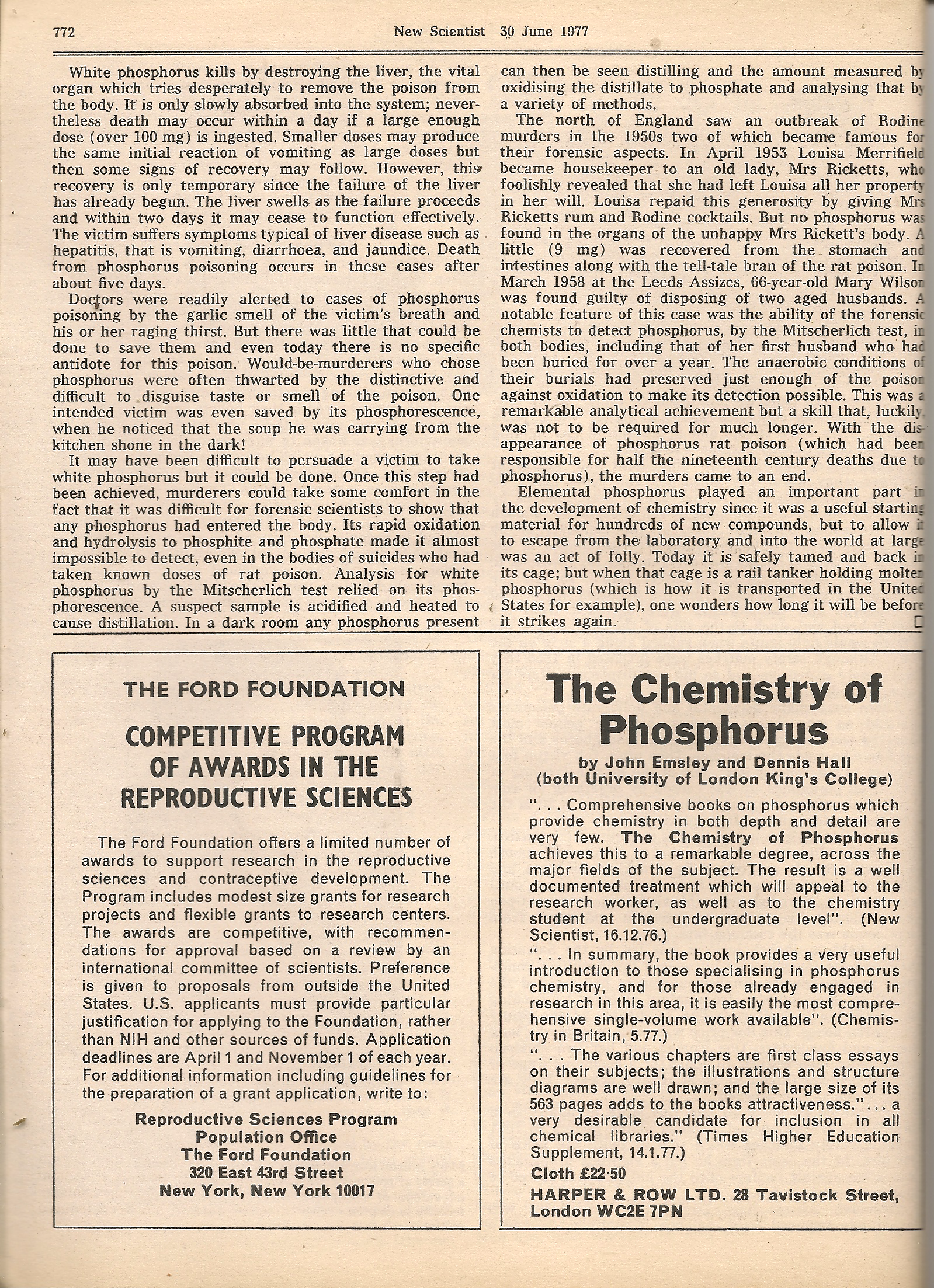“White phosphorus has three unusual properties: it glows in the dark, it bursts into flames when exposed to air, and it is a deadly poison. Little wonder that it aroused the interest of the early chemists and has left in its wake a trail of minor tragedies and major catastrophes.”
In another post concerning phosphorus, this New Scientist article from June 1977 outlines the story of the discovery of the elemental form by Hennig Brandt and quite a bit more history that has transpired since that fateful first illumination. John Emsley would later write “The shocking history of phosphorus”, alternatively known as “The thirteenth element-A biography of The Devil’s element” for the American market. This appears to be an early precis version of this book, but gives compact detail about how white phosphorus has been used both foolishly and with malice.
“Phosphorus firebombs were the most immoral use to which the element has ever been put. These devices played a minor but terrible part in the frenzied urban holocausts inflicted on European and Japanese cities in the latter half of the Second World War. The burns produced by droplets of blazing phosphorus were notorious for their deep penetration, intense pain, and slowness in healing. Deployment of these weapons led to the same feeling of outrage that a later generation expressed about napalm.”
From quack doctors and match making madness to murder and war, Emsley covers it all in this article, with pointers to some environmental incidents as well. Albright and Wilson are of course mentioned, though at this point in history their company was going down the swanny in its own steam. We do learn from the piece that in 1977, production of p4 was at over 2 million tonnes, this just 14 years after the chemical had been banned in Britain for rodenticide use being a “cruel poison” .
Emsley offers a frank account of the chemical which probably did little favour for its manufacturers corporate attempts to paint their industries social responsibility agenda. In 1977 this was important and the spotlight was very much on legal reform of the waste industry in Britain. One can imagine the top brass at Albright and Wilson feeling a little uneasy under the collar when reading such a piece and candid appraisal of their element’s use, deliberately omitted in their company history “100 years of phosphorus making” published 26 years previously. Unfortunately however appearing in such a title as The New Scientist and before the advent of the internet age the information would not be read at large by the public- the ones that needed to know what that chemical factory down the road in Oldbury and others like them were actually doing with such a chemical on their doorstep.
It would have been good if the West Midlands County Council and in particular the fool of a county waste disposal officer when passing the site licence in December of that year had actually read such an article, and furthermore taken on some of the facts on board.
“There appear to be no environmental implications in the continued use of the site.” was what Ken Harvey decreed , and how wrong he was- totally in every respect.
The final paragraph is perhaps the most telling in relation to Rattlechain and Rhodia/Solvay’s burial of the chemical under water. The bird deaths at the site over the years just open up a can of worms that continue the “shocking history” of the chemical and also the shocking way that those in charge of such sites appear more in awe of it to be able to stop its wrath.
“Elemental phosphorus played an important part in the development of chemistry since it was a useful starting material for hundreds of new compounds, but to allow it to escape from the laboratory and into the world at large was an act of folly. Today it is safely tamed and back in its cage; but when that cage is a rail tanker holding molten phosphorus (which is how it is transported in the United States for example), one wonders how long it will be before it strikes again.”






